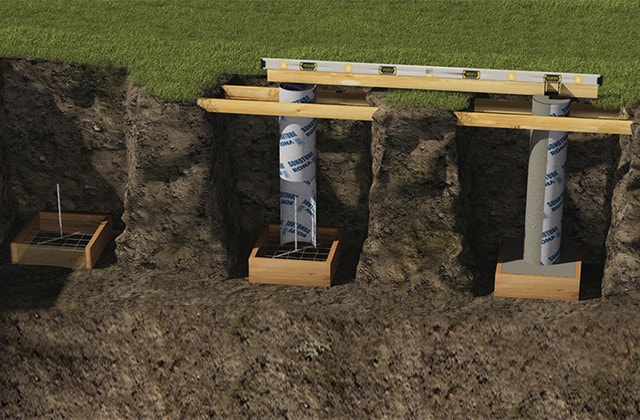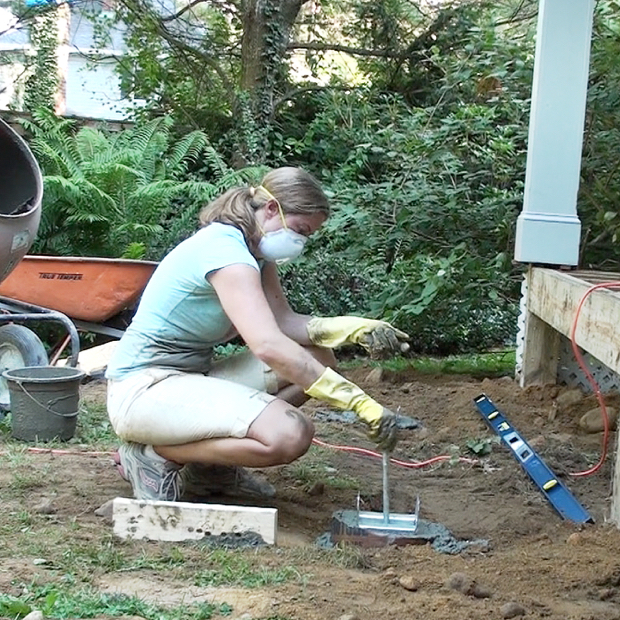Deck Footings Revealed: Understanding the Secret Elements of a Trusted Deck Structure
Deck Footings Revealed: Understanding the Secret Elements of a Trusted Deck Structure
Blog Article
Selecting the Right Deck Footings for Security and Resilience
When it pertains to developing a deck, among the most crucial decisions you will make is selecting the right footings for security and toughness. The durability and safety and security of your deck depend heavily on the kind of footings you pick, as they give the important support and security to hold up against the test of time. With a myriad of options offered, it can be overwhelming to figure out which grounds are best fit for your specific needs. In this conversation, we will certainly discover the different kinds of deck grounds, consider the important elements to weigh when choosing, and explore the benefits and drawbacks of different options. By the end, you will have a clearer understanding of the selections at hand and be much better geared up to make a notified decision for your deck task.
Kinds of Deck Grounds
These grounds consist of a round opening filled up with concrete, which offers a strong foundation for the deck blog posts. Concrete pier grounds are relatively easy to set up and supply outstanding stability, making them a preferred choice for several deck jobs.
One more sort of footing is the helical heap ground. Helical piles are steel shafts with helical plates connected to them. These footings are installed by screwing them into the ground, which produces a safe foundation for the deck. Helical pile footings are optimal for areas with difficult soil conditions, as they can be set up in practically any kind of soil. If needed., they also allow for easy adjustment and progressing of the deck.
Additionally, some contractors select precast concrete grounds. These grounds are constructed from sturdy concrete and come in different forms and dimensions to suit various deck designs. Precast concrete grounds are practical to set up and provide a secure base for the deck structure.
Finally, another option is the post-in-anchor footing system. This kind of ground entails driving a metal support right into the ground and affixing it to the deck blog post. It uses versatility in terms of placing the deck blog posts and is suitable for decks with light-weight frameworks.
When choosing the right kind of deck ground, it is crucial to take into consideration factors such as dirt problems, deck tons, and neighborhood building regulations (Deck Footings). Consulting with an expert contractor or architectural engineer can assist guarantee the suitable footing is picked for a secure and safe deck
Factors to Think About When Picking Footings
When selecting the proper footings for a deck, it is critical to carefully take into consideration various aspects such as dirt problems, deck load, and adherence to local building ordinance. These aspects play a substantial duty in guaranteeing the security and sturdiness of the deck structure.
The type of dirt on which the deck will certainly be constructed identifies the kind of footings required. On the various other hand, decks developed on clay or large soils may need grounds that can suit the dirt's propensity to expand and contract.
One more crucial aspect is the deck load. The weight of the deck, consisting of the materials made use of and any possible real-time lots such as furnishings or events, need to be thought about when selecting grounds. The footings must be created to birth the weight of the deck and disperse it equally to avoid any architectural issues or failings.
Last but not least, adherence to regional building ordinance is vital. Structure codes differ from area to area, and it is essential to comply with the details needs established by the neighborhood authorities. Deck Footings. These codes make sure that the deck is built safely and meets the required requirements for architectural integrity and load-bearing capability
Concrete Grounds: Cons and pros

Concrete footings supply numerous benefits and drawbacks when utilized as the foundation for a deck. On the silver lining, concrete grounds offer exceptional security and durability. Concrete is a solid and inflexible material that can support hefty loads and hold up against different climate conditions. It also has a lengthy lifespan, making it a trusted selection for lasting use.
Another advantage of concrete grounds is their convenience. They can be poured right into different shapes and sizes to accommodate various deck styles and setups. Concrete grounds can be customized to fit the certain requirements and requirements of the deck framework.
Nevertheless, there are additionally some drawbacks to using concrete grounds. One significant drawback is the cost and labor involved in their setup. Concrete grounds require excavation and often need the aid of hefty equipment. This can raise the total cost of the deck task and may call for specialist help.

Helical Piers Vs. Sonotubes: Which Is Much better?
In thinking about the foundation alternatives for a deck, the contrast between helical piers and sonotubes is important in identifying the premium option. Helical piers, likewise known as screw piles, are steel shafts with helical why not try here plates connected to them. They are twisted right into the ground using hydraulic equipment, providing a steady and durable foundation for the deck. On the other hand, sonotubes are cylindrical kinds made from cardboard or fiber material that are loaded with concrete. They are positioned in an opening explored the ground and provide assistance for the deck.
When it involves security and durability, helical piers have the top hand. The helical plates on the piers develop a solid hold with the soil, protecting against any type of activity or shifting of the deck. This is particularly beneficial in locations with unsteady or changing soil problems. Sonotubes, on the other hand, depend solely on the concrete filling up for stability, which might not use the exact same level of stamina and resistance.
In regards to installation, helical piers are fairly much easier and faster to mount compared to sonotubes. The hydraulic machinery made use of to twist the piers right into the ground guarantees a fast and effective procedure. Sonotubes, on the other hand, call for digging holes and putting concrete, which can be time-consuming and labor-intensive.
Additionally, helical piers are a more versatile alternative. If needed, they can be used in various dirt problems and can be readjusted or strengthened. Sonotubes, on the other hand, might call for additional support, such as rebar, in certain soil conditions or locations with high load demands.
Selecting the Right Footings for Your Deck's Measurements
For optimum architectural honesty, it is important to meticulously select the suitable footings that align with the measurements of your deck. The dimensions of your deck, including its width, height, and size, play a considerable function in determining the type and size of grounds needed.
When picking grounds for your deck, it is very important to consider the load-bearing capability of the soil. find more information The weight of the deck, incorporated with the weight of any type of furniture or individuals on it, puts in a substantial force on the grounds (Deck Footings). It is critical to choose grounds that can appropriately support this weight without moving or sinking over time.
The dimension and form of the grounds need to likewise be taken into consideration. Larger decks with greater measurements require larger footings to offer adequate stability and support. The form of the grounds, whether they are square or rounded, depends on the design and layout of the deck. Furthermore, the depth at which the grounds read the full info here are mounted need to be determined based on the frost line in your area to stop any heaving or shifting due to freezing temperatures.
Final Thought
In final thought, selecting the best deck grounds is crucial for making sure stability and longevity. Aspects such as the kind of grounds, the deck's dimensions, and the pros and cons of various choices should be taken into consideration. Concrete grounds use stamina and longevity, however might be extra taxing and pricey to set up. Helical piers and sonotubes have their very own benefits and negative aspects. Ultimately, picking the suitable footings for your deck's specific demands is essential for a long-lasting and effective structure.
These footings are composed of a cylindrical hole filled with concrete, which supplies a strong foundation for the deck messages. Concrete pier grounds are fairly very easy to install and provide exceptional security, making them a preferred option for lots of deck projects.
Precast concrete grounds are practical to install and provide a secure base for the deck framework.
It uses versatility in terms of placing the deck messages and is suitable for decks with light-weight structures.
Concrete grounds supply several advantages and negative aspects when made use of as the structure for a deck.
Report this page